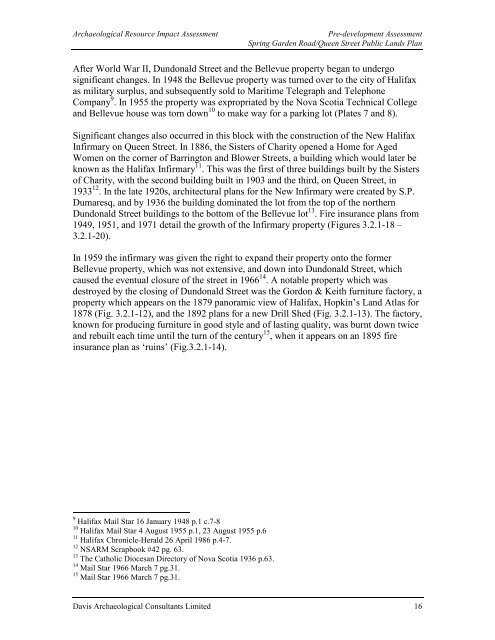Phase I - Halifax Regional Municipality
Phase I - Halifax Regional Municipality
Phase I - Halifax Regional Municipality
You also want an ePaper? Increase the reach of your titles
YUMPU automatically turns print PDFs into web optimized ePapers that Google loves.
Archaeological Resource Impact Assessment<br />
Pre-development Assessment<br />
Spring Garden Road/Queen Street Public Lands Plan<br />
After World War II, Dundonald Street and the Bellevue property began to undergo<br />
significant changes. In 1948 the Bellevue property was turned over to the city of <strong>Halifax</strong><br />
as military surplus, and subsequently sold to Maritime Telegraph and Telephone<br />
Company 9 . In 1955 the property was expropriated by the Nova Scotia Technical College<br />
and Bellevue house was torn down 10 to make way for a parking lot (Plates 7 and 8).<br />
Significant changes also occurred in this block with the construction of the New <strong>Halifax</strong><br />
Infirmary on Queen Street. In 1886, the Sisters of Charity opened a Home for Aged<br />
Women on the corner of Barrington and Blower Streets, a building which would later be<br />
known as the <strong>Halifax</strong> Infirmary 11 . This was the first of three buildings built by the Sisters<br />
of Charity, with the second building built in 1903 and the third, on Queen Street, in<br />
1933 12 . In the late 1920s, architectural plans for the New Infirmary were created by S.P.<br />
Dumaresq, and by 1936 the building dominated the lot from the top of the northern<br />
Dundonald Street buildings to the bottom of the Bellevue lot 13 . Fire insurance plans from<br />
1949, 1951, and 1971 detail the growth of the Infirmary property (Figures 3.2.1-18 –<br />
3.2.1-20).<br />
In 1959 the infirmary was given the right to expand their property onto the former<br />
Bellevue property, which was not extensive, and down into Dundonald Street, which<br />
caused the eventual closure of the street in 1966 14 . A notable property which was<br />
destroyed by the closing of Dundonald Street was the Gordon & Keith furniture factory, a<br />
property which appears on the 1879 panoramic view of <strong>Halifax</strong>, Hopkin’s Land Atlas for<br />
1878 (Fig. 3.2.1-12), and the 1892 plans for a new Drill Shed (Fig. 3.2.1-13). The factory,<br />
known for producing furniture in good style and of lasting quality, was burnt down twice<br />
and rebuilt each time until the turn of the century 15 , when it appears on an 1895 fire<br />
insurance plan as ‘ruins’ (Fig.3.2.1-14).<br />
9 <strong>Halifax</strong> Mail Star 16 January 1948 p.1 c.7-8<br />
10 <strong>Halifax</strong> Mail Star 4 August 1955 p.1, 23 August 1955 p.6<br />
11 <strong>Halifax</strong> Chronicle-Herald 26 April 1986 p.4-7.<br />
12 NSARM Scrapbook #42 pg. 63.<br />
13 The Catholic Diocesan Directory of Nova Scotia 1936 p.63.<br />
14 Mail Star 1966 March 7 pg.31.<br />
15 Mail Star 1966 March 7 pg.31.<br />
Davis Archaeological Consultants Limited 16
















